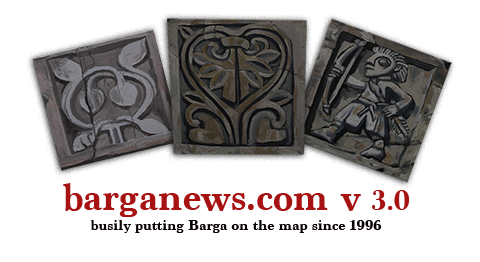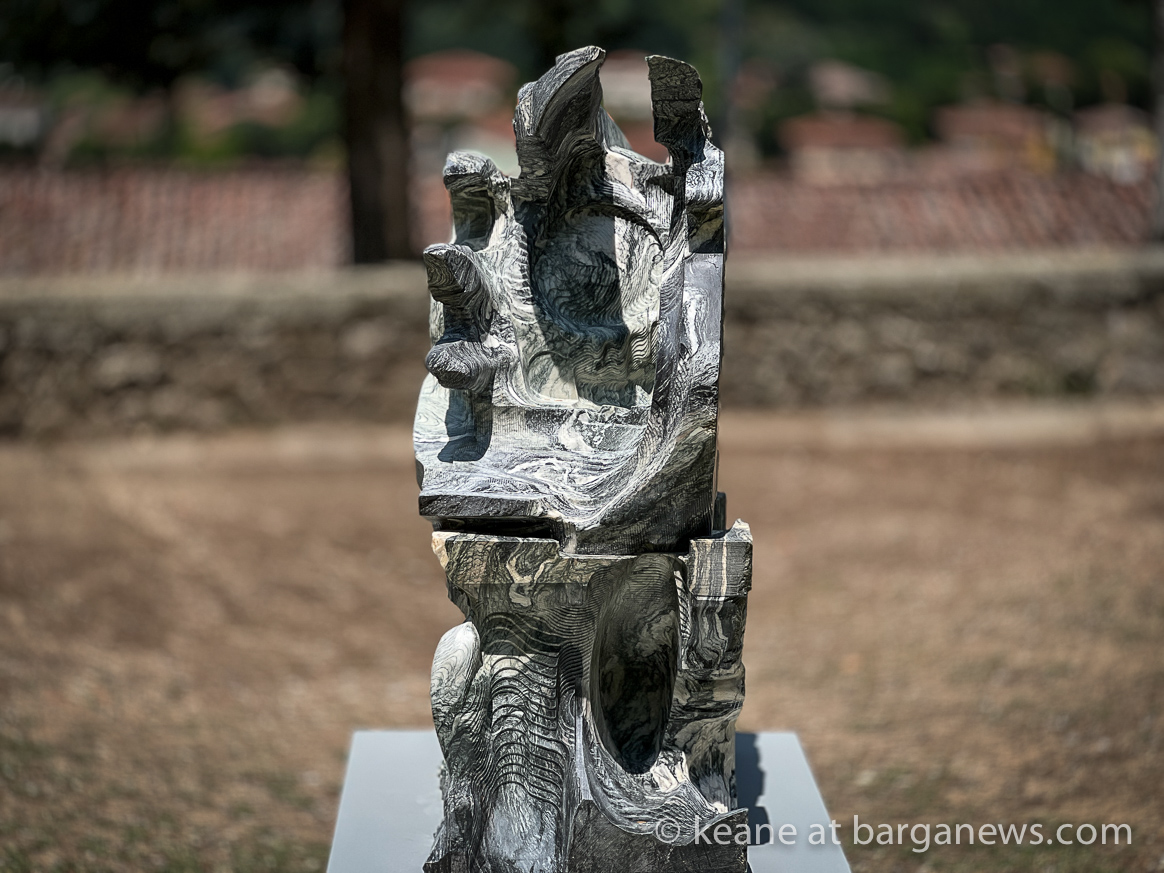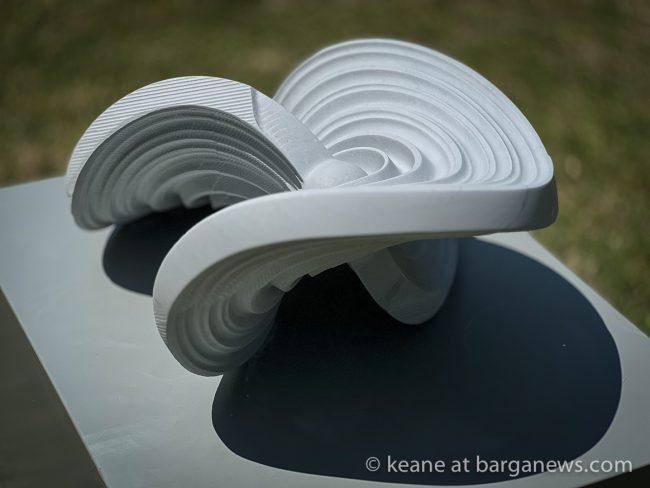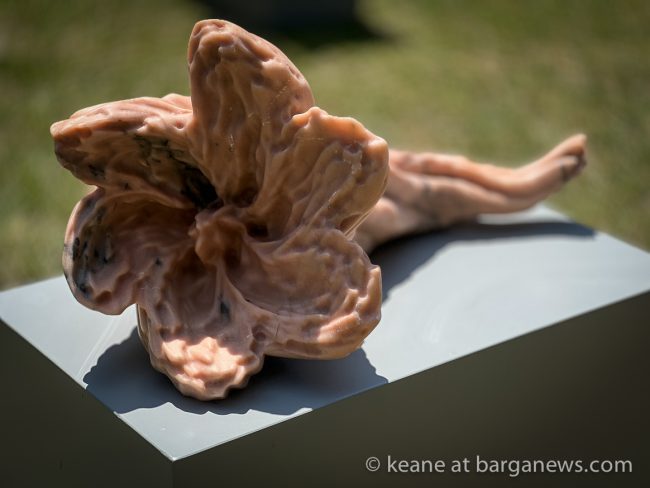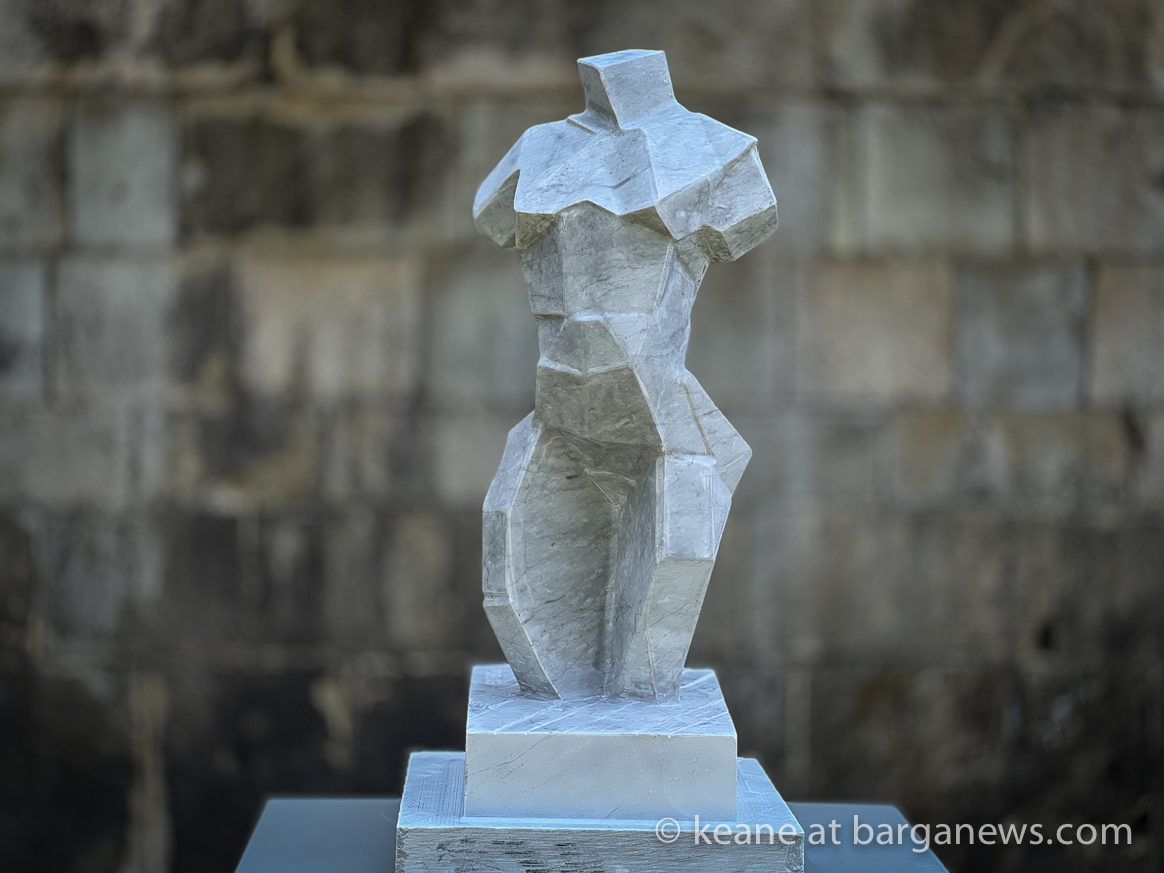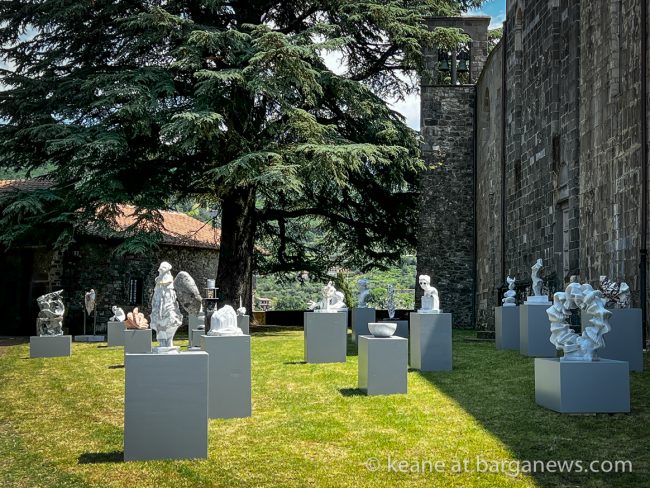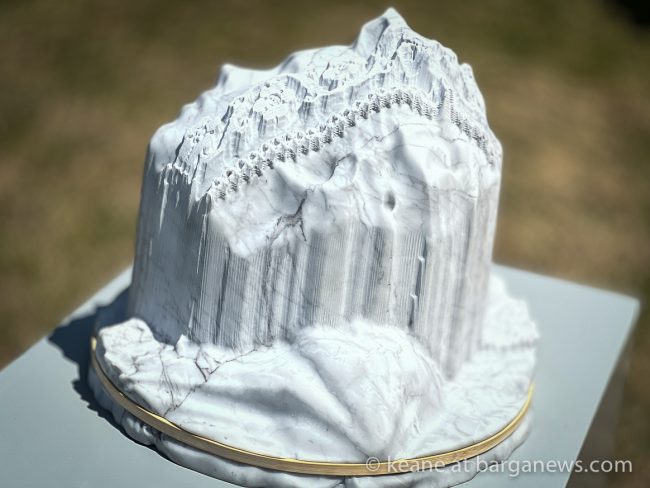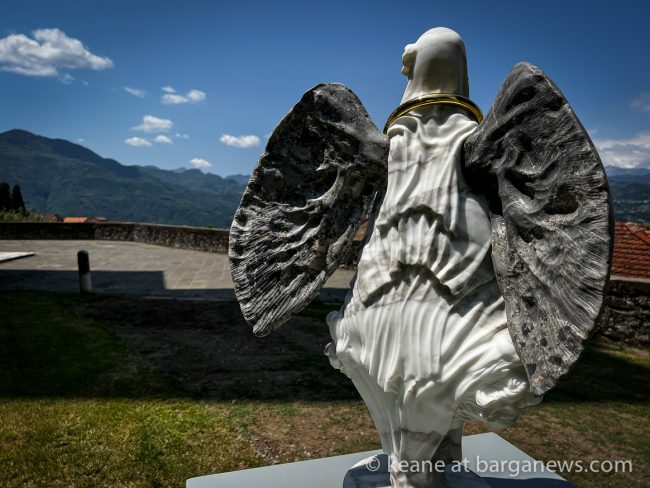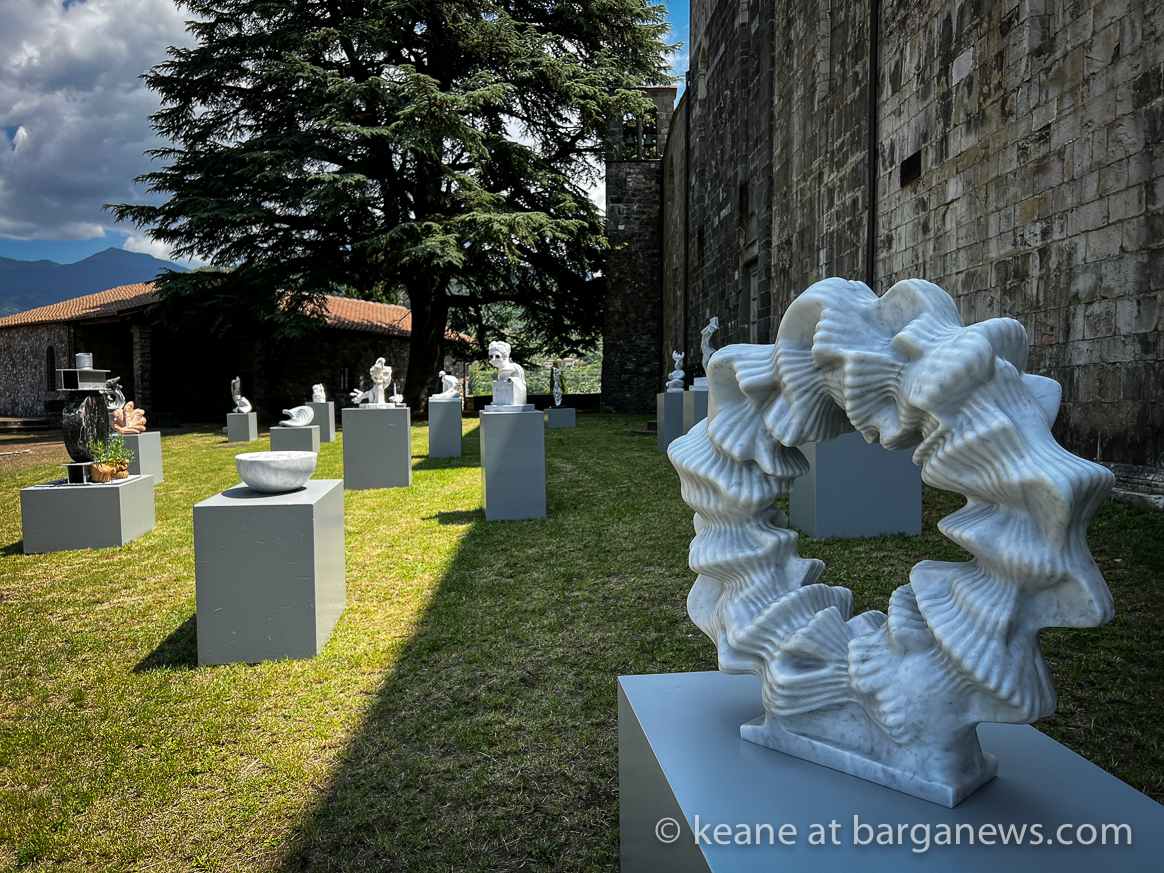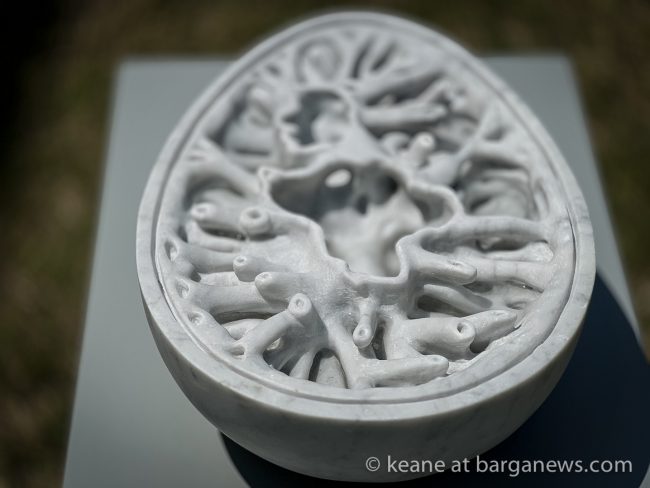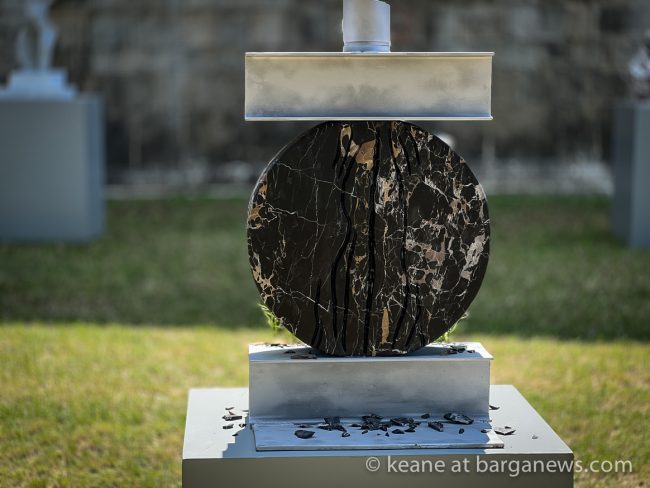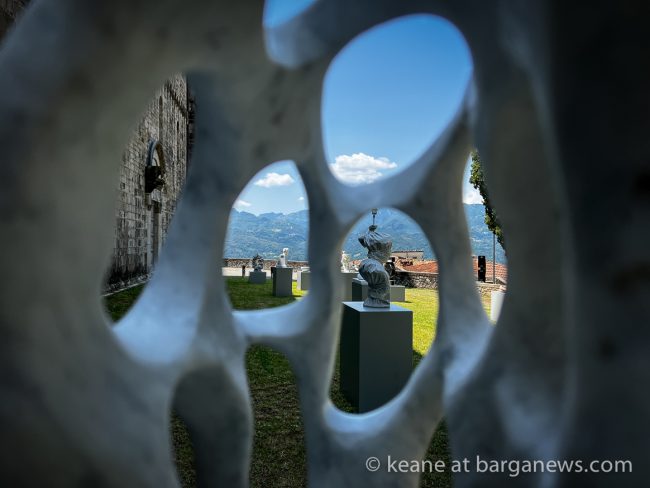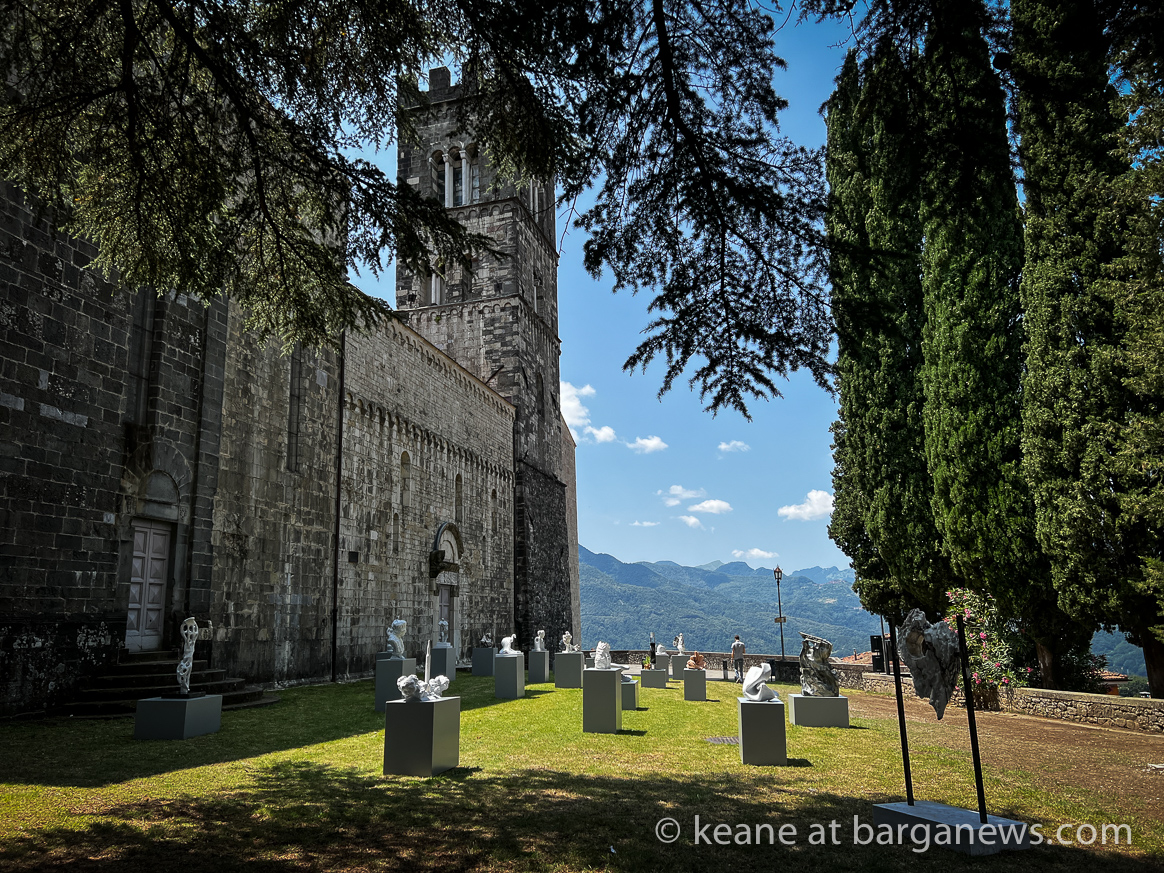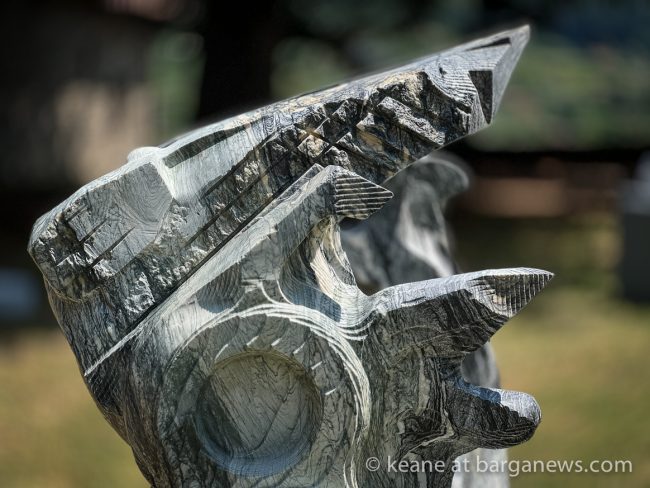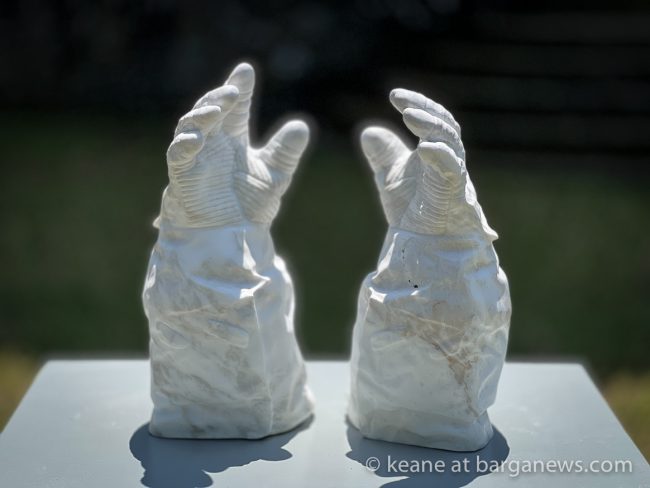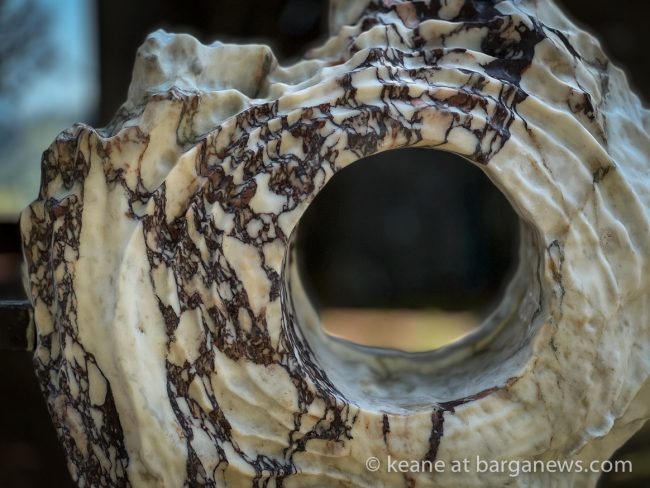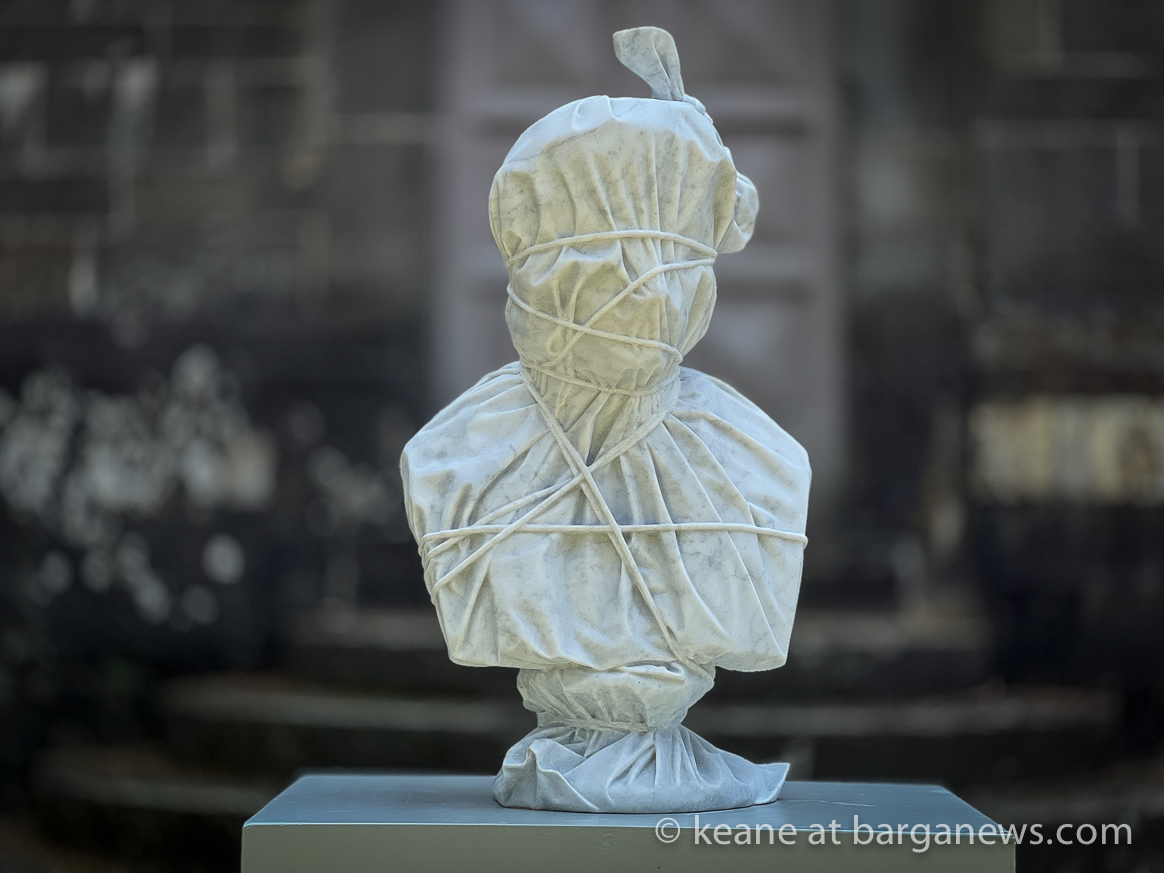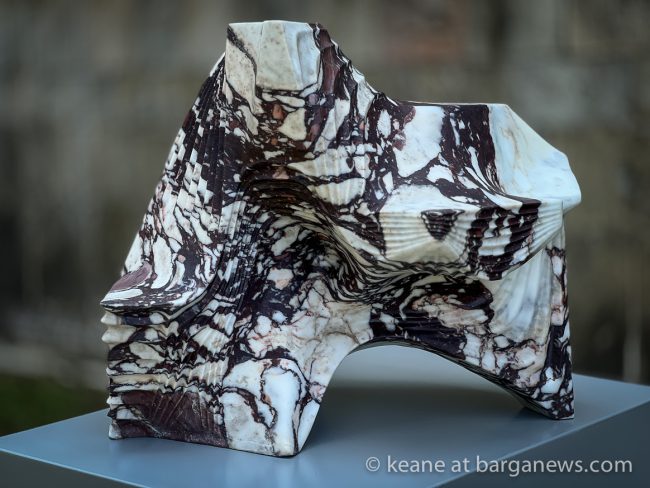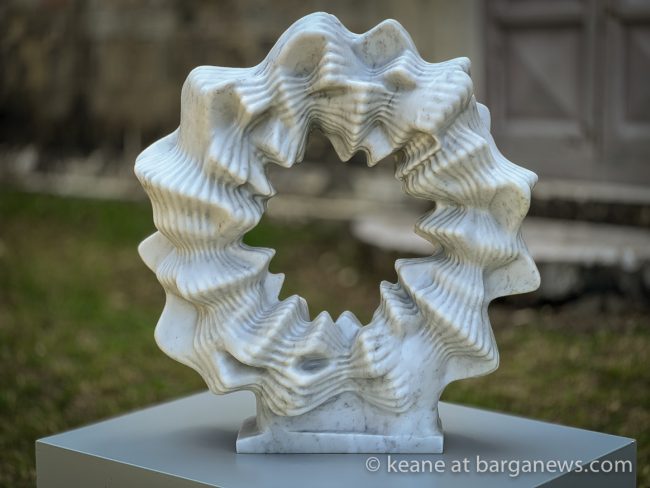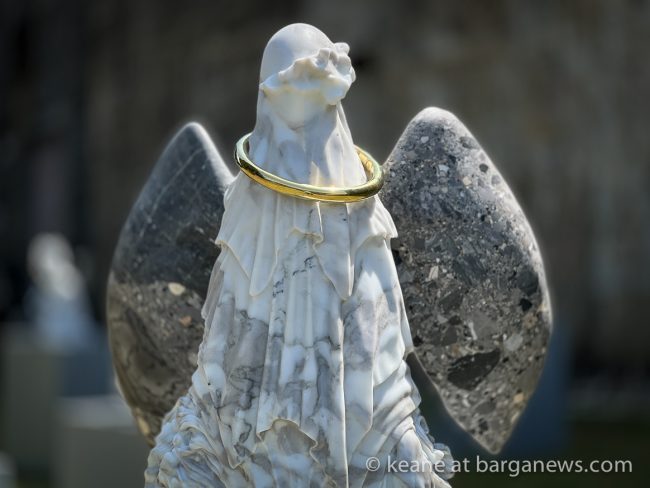On the Arringo del Duomo in Barga Vecchia – a Techno-Lithic exhibition of marble sculptures made with digital technologies by international artists.
This exhibition presented the work of twenty-one international artists who participated in a sculpture residency in Gramolazzo, using local marble and digital technologies to create innovative sculptural forms. A historical center for marble production, Gramolazzo is today home to the most advanced technologies in artistic stone carving. Through a unique collaboration between the American Digital Stone Project (DSP) and the Tuscan Garfagnana Innovazione (GI), artists from around the world spent one month in Gramolazzo working with 3D imaging and robotic carving machines to create sculptures using ancient stone quarried in the region.
“The magnificent architecture of the Duomo provided a fitting historical setting for contemporary works that engaged with both modern technology and ancient materials. Holding the exhibition in Barga for the first time was a wonderful opportunity to share further the innovative sculptures that were made in the region” – Jon Isherwood, founder of DSP
The month-long residency afforded artists the opportunity to become immersed in the materials and traditions intrinsic to Tuscany. Techno-lithic included works that took abstract data as a starting point, coded it into form, and then pushed its definition and refinement into complex works carved in marble. Cosmic events, gravitational waves, the molten core of the earth, were among the themes explored by the artists. The interactive nature of the digital design process offered new possibilities to overlay and collage imagery together, allowing abstract and immaterial narratives to reveal surprising material shapes in the carved marble.
At the other end of the spectrum were artists using stone as a means of exploring new forms of figuration that challenged traditional contexts. The capacity of modeling in virtual space using a digital modeling program prompted a contemporary overlay and inflection to classical forms.
The collaboration between DSP and GI began in 2013, with a mission to provide opportunities for artists, architects, and designers to experiment with state-of-the-art technologies. DSP was a non-profit American organisation that offered artists the potential to achieve the highest levels of creative expression using 3D technology.
GI was founded in 2011 to reinvigorate the marble industry in Gramolazzo, an area in the region of the Apuan Alps that historically served as a marble distribution center. GI worked with international artists to realize contemporary projects in marble using advanced robotics and digital technologies.
www.digitalstoneproject.com
www.garfagnanainnovazione.it
Patrick Bermingham
Patrick Bermingham’s work has been recognized for its elegance, simplicity, depth of thought, clarity of purpose and constructivist approach. He has experience working in a variety of materials, from paper, terracotta, wood, forged steel, stone and bronze. Exhibitions from 1974 to 2023 including: St Martin’s School of Fine Art; MASS MOCA; Art Gallery of Burlington’s Moonglade; Art Gallery of Burlington’s No Vacancy; Cross MacKenzie Gallery, Washington DC; The Artist Project, Toronto; The Beckett Gallery, Hamilton, On; European Cultural Center, Personal Structures; and Time Space Existence Exhibition at the European Cultural Centre, Venezia, Italy. The Florence Biennale 2021. Recently a commission for the City of Pickering, ON, Canada, “One Horsepower”.
Claudia Dietz is an experienced stone sculptor and has studied fine arts with an emphasis on sculpture at the State Academy of Fine Arts in Stuttgart, Germany. In her work you will find a purist and archaic influence. Her metamorphoses in stone appear lively and curious with nature always in the center. A significant role is always played by the ironic-humorous undertone, that can be discovered well, in her best-known work cycle „Krümmertierchen“.
Many of her sculptures are in public, private and museum collections and sculpture parks around the world, including Spain, France and the United States. Her work has been featured in both national and international press.
Travis Donovan is a North Carolina interdisciplinary artist. He is an Assistant Professor and Sculpture Area Coordinator at Appalachian State University in Boone, NC. Donovan employs a range of techniques from traditional casting and fabrication practices to studies in digital fabrication, kinetics, and new media. He explores the relationships between objects, patterns, and utilitarian materials of the American South and their links to identity, masculinity, and fatherhood. Donovan became a North Carolina Artists Fellow after receiving his MFA from the University of North Carolina in 2011. His work has been exhibited at Kennedy Museum of Art, CICA Museum, and The William King Museum. His work has been collected by The Yingge Ceramics Museum in New Taipei City, Taiwan.
Jon Isherwood
Isherwood’s Sculpture has been widely exhibited in public and private galleries and Museums in US, Canada, Europe, and China. Including over 30 solo exhibitions, his work can be found in 25 public collections, completed over 30 commissions including 100M Chicago, the Department of Health NJ, the US State department Art in Embassies program in Oslo Norway, and recently exhibited 8 sculptures on Broadway NYC. Isherwood’s work has been reviewed in The New York Times, Art in America, Art News, Sculpture Magazine, London Times. He has made personal appearances including WAMC Public Radio, The Culture Show, BBC Television,
NY1and CBS NY. He has lectured at numerous Colleges and Universities in the U.S, Europe and China. Jon is the President and founding member of the Digital Stone Project.
Simona Lombardi
Born 1998 in Pietrasanta, Italy a town with a strong vocation for art, stimulated Simona’s interests toward an education in the field of cultural heritage. Leading her studies to secure a degree in restoration of metal, glass, and ceramic objects at the University of Bologna – Campus of Ravenna where she lived for 5 Years.
For Simona’s final thesis project, she restored an artwork belonging to the collection of the International Museum of Ceramics in Faenza that had been damaged during a World War II bombings. Her proximity to Emilia Romagna led her to participate in the recovery operations at the museums where many artworks were damaged, covered in mud due to the very recent flooding disaster.
Helena Lukasova was born in Brno, Czech Republic. Currently she is teaching at the Faculty of Informatics, Masaryk University Brno where she is the head of The Studio of Graphic Design and Multimedia. Helena Lukasova holds a Ph.D. from the Academy of Fine Art and Design, Bratislava 2005 – 2009. The focus of her studies was on digital sculpture. She holds a Master‘s degree in sculpture, from the Academy of Fine Art and Design, Bratislava, SK, 1990 – 96 . She also studied and worked at the Johnson Atelier – Technical Institute of Sculpture, N.J., where she witnessed the power of digital fabrication first hand an experience that defined her further direction. As an artist she looks at the potential of digital sculpture which challenges the traditional understanding of sculpture as a physical object in material form.
Kailey Maher (b.1988) is a visual artist and dreamer of impossibility. She is a second-generation stone carver. In 2022 she received her BFA from the State University of New York at Plattsburgh with a focus on sculpture and ceramics. Her artwork has been shown in numerous group exhibitions, including “NY/VT Artist in Residence at Salem Art Works” at North Main Gallery, Salem, New York and “Flora|Fauna|Fiction” at Wildfire Ceramics Studio, Missoula, Montana. She has also been selected for several grants and awards including William Lee Scholarship Grant by Trendspot, Inc., San Bernardino, California and Albert K. Murray Fine Arts Educational Fund Grant, Adamsville, Ohio. Her artwork is held in the SUNY Plattsburgh Permanent Art Collection in Plattsburgh, New York.
Yuan Mu is a computational designer currently working at Nike Innovation. During the days, her design and research is specialized in wearable technology centered around methods of making; in her spare time, she explores creativity through digital media and analog art. As a person who is passionate about art, Yuan is expanding her tools and perceptions through different transactions in life. Before joining Nike, she worked in architecture and visualization offices in Boston and Los Angeles. Yuan holds her Master of Design Studies in Technology from Harvard Graduate School of Design, Master of Architecture from Southern California Institute of Architecture, and her Bachelor of Art History with concentration on Northern Renaissance from University of Arizona with Distinction.
Mary Neubauer’s practice focuses on sculptural manifestations of data streams and public art projects involving interactivity, light, & sound. Positioned at the crossroads of art and science, her work has appeared in exhibitions internationally. She has been a guest artist at the Anderson Ranch Center for the Arts, the Tyrone Guthrie Center, the American Academy in Rome, the John Michael Kohler Arts/ Industry program, the Arctic Circle Expedition, and was a Fulbright Fellow in Cambridge, UK. Mary is a President’s Professor of Sculpture at the Herberger Institute for Design and the Arts at Arizona State University.
Marc O’Brien (Doras) is a multi-disciplinary artist based in Montréal, QC, whose work is driven by a passion for making art more accessible to the public. He holds a Bachelor of Design in illustration from OCAD University (2012) and has worked for the past decade as an artist and
director in film, advertising, publishing, and now public art. As a street artist, he creates murals and installations that draw from his background in illustration and place a strong emphasis on scale, contour, and color relationships. His work often blends historical ornament and iconography with the language of contemporary fantasy to create a rich vocabulary of symbols and characters, inviting the viewer to immerse themselves in an adjacent world as a way to better understand our own.
Godshand Owusu-Appiah, is an MFA student in Metals (Sculpture) at the Herberger Institute for Design and the Arts at Arizona State University, where teaches 3D Core, Jewelry, and Metalsmithing. Before coming to ASU, he received an MFA degree in Jewelry and Metalsmithing from Kwame Nkrumah University of Science and Technology in Ghana. In 2021 , he received one of ASU’s top scholarships. Godshand created a series of monumental vessels for the 2022 Emerge Festival, a large public event addressing food supply and sufficiency. He recently won the first place GPSA award at ASU’s multi-cultural Center exhibition.
Alicia Proudfoot
The body is the thematic root of Alicia’s practice. A sick body, in her case an asthmatic body, creates friction with society’s mandates of idealized beauty, strength and health. Alicia critiques these rigid qualifications through sensational design. Explicitly satirizing her diseased body, she addresses what it means to make asthma a commodity. Her humour is deliberately chameleon, fritzing between representational gimmickry and abstraction. With absurd tactics, Alicia reinterprets asthma as entertaining things like a three-part musical Ode to her inhalers; a polyp covered marble yoyo; and recently, an enlarged steel breathing bouquet of oil filter flowers. Alicia has an MFA from NSCAD University and lives in Canada with her harp and plants.
Namita Purohit is an architect and keen artist from India. After graduating from Oxford Brookes University with a master’s degree in advanced architecture design, she gained valuable experience in London at a notable classical architecture practice, and in Mumbai, focusing on modern architecture. Currently, she runs her boutique architecture studio and practices with a human-centered approach as its foundation. Drawing inspiration from simple everyday objects, Namita often works at the intersection of art and architecture, exploring how they can inform and enhance each other. Furthermore, Namita actively participates in her family’s natural stone business and is preparing to launch a design unit that celebrates the fusion of art, design, and natural stones with a collaborative approach.
John Rainey (b. 1985) is a sculptor based in Belfast, Northern Ireland. He received his MA in Ceramics and Glass the Royal College of Art, London (2012), and his BA in Contemporary Crafts at Manchester Metropolitan University (2009). He has previously undertaken residencies at the British School at Rome (2018) and Konstfack University of Arts, Craft and Design (Stockholm, 2013). Recent solo exhibitions include ‘STATE SHIFT’ at Berg Gallery, Stockholm (2022), and ‘SLIP TANK’ at the Naughton Gallery at Queen’s University, Belfast (2021).
Rainey’s work features in public collections including the Ulster Museum, the UK Government Art Collection, the Arts Council of Northern Ireland Collection and the Royal College of Surgeons in Ireland Art Collection.
Primarily a sculptor, William Ransom’s work originates at the intersection of his material engagement and his investigations into personal history, collective history and agricultural experience. Ransom’s work has been shown in solo and group exhibitions in New York, Chicago, Detroit and Los Angeles and more. His most recent solo show was “HoldUp/UpHold” at NE Sculpture in Minneapolis. Ransom received an MFA in Sculpture from Claremont Graduate University in 2008 and a BA in Sculpture from Bennington College in 2004. He is Faculty in the Program in Art at The California Institute of the Arts.
Chris Sancomb is an interdisciplinary artist, designer and educator with a hybrid practice in design and studio arts. His studio work is focused on creating visual experiences that represent unobservable phenomena within the architecture of the universe. This work represents an expression of wonder at the elusive magnitude of Space, and serves as a way of obtaining knowledge and understanding through inquiry, synthesis, material exploration and making.
His socially engaged design practice is focused on creating inclusive, interactive,and hands-on community based design collaborations that promote empathy, and help develop creative confidence.
Sumit Sarkar is a sculptor and painter working with digital and traditional techniques. Recent work has moved away from a lifetime of figurative work, which took inspiration from and subverted religious, sci-fi, comic/cartoon, and graffiti iconography, to work focussed on abstracted sculptural form. The newer abstract work is nonetheless imbued with visual and thematic echos of the previous figurative work. New technology is at the forefront of Sumit’s practice with recent projects exploring milling with a 7-axis robot arm, Virtual and Augmented Reality, motion capture, and multi-material 3D print. Technology and process often inform the idea.
Michael Searle is an Interdisciplinary Studies student at Arizona State University with concentrations in art and film. He is determined to synthesize these creative fields to develop innovative sculptures with compelling stories by bridging the gap between the traditions of old and the technology of new. He is an aspiring polymath, with interests that range from woodworking, foundry, and blacksmithing to digital modeling, rapid prototyping, and extended reality. He intends to utilize the knowledge he has gathered in college to kickstart his journey of becoming a lifelong learner and fabricate anything he imagines.
Aaron T Stephan’s work presents a wry look at the world– focusing on the complex web of information carried by everyday materials and objects. His work has been featured at venues including Locust Projects, DeCordova Sculpture Park & Museum, Samson Projects, The Portland Museum of Art, John Michael Kohler Art Center, California Center for the Arts, Farnsworth Art Museum, Weitz Center at Carlton College, ICA at MECA, DUMBO Center for the Arts, Troy Arts Center, University of Maine Museum of Art, Quint Contemporary, and Albany Airport Gallery. Aaron has completed public commissions across the U.S. including Boston, MA, Denver, CO, Manchester NH, Lubbock, TX, El Paso, TX, Salt Lake City, UT, Nashville, TN, Indianapolis, IN, San Diego, CA, Tampa, FL, and Portland, ME amongst others.
Jeremy Tarr was born to a blue collar family and raised in the working class neighborhoods of Pittsburgh, Pennsylvania, US. Tarr works as an instructor at Syracuse University teaching Digital Sculpture in the Studio Arts concentration and as a technical fabricator in the School of Architecture. He received his MFA at Syracuse University and has exhibited domestically and internationally in Pittsburgh, Berlin, NYC, and LA. Tarr has been an artist in residence at the Axel Haubrok Fahrbereitschaft in Berlin and Governors Island, NYC. Tarr’s work is informed by the landscape of the Appalachian rust-belt and its mythologies. At the core of his practice is the presence of the empty, the physicality of the immaterial, and the complexities of unknowing as a means of liberation.
Ashley Zelinskie
Ashley Zelinskie is Brooklyn-based conceptual artist utilizing a post-New Media approach. Her works span a variety of media, from large- and small-scale sculpture to canvas and print works, each created using cutting edge technology such as 3D printing, computer-guided laser cutting, and satellite plating technology. Her work focuses on visualizing data in abstract forms and finding new and interesting ways to describe complex ideas. Often she will work alongside scientists and engineers at institutions such as NASA and the Smithsonian to integrate new discoveries into her work.
Ashley’s work has been featured by Vice, the New York Times and Hyperallergic. Her work forms part of the permanent collection of the US State Dept, Art Nabi Center in Seoul, Onassis Foundation in Athens, and Yerkes Observatory. She has been exhibited at Sotheby’s NYC and most recently the ArtScience Museum in Singapore. Ashley is a former resident of New Inc.—the New Museum’s Art and Technology Incubator and a member of ONX Studio.
 |
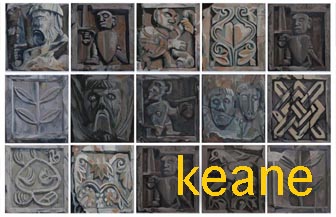 |
 |
 |
Sull’Arringo del Duomo a Barga Vecchia si è tenuta una mostra Techno-Lithic di sculture di marmo realizzate con tecnologie digitali da artisti internazionali.
Questa mostra presentava il lavoro di ventuno artisti internazionali che hanno partecipato a una residenza di scultura a Gramolazzo, utilizzando marmo locale e tecnologie digitali per creare forme scultoree innovative. Gramolazzo è un centro storico per la produzione di marmo ed è oggi sede delle tecnologie più avanzate per la scultura artistica in pietra. Attraverso una collaborazione unica tra l’American Digital Stone Project (DSP) e la Garfagnana Innovazione (GI) toscana, artisti provenienti da tutto il mondo hanno trascorso un mese a Gramolazzo lavorando con immagini in 3D e macchine per la scultura robotica per creare sculture utilizzando antiche cave di pietra della regione.
“La magnifica architettura del Duomo forniva un contesto storico adatto per opere contemporanee che si confrontavano sia con la tecnologia moderna che con i materiali antichi. Tenere la mostra a Barga per la prima volta è stata un’opportunità meravigliosa per condividere ulteriormente le innovative sculture realizzate nella regione” – Jon Isherwood, fondatore del DSP.
La residenza di un mese ha offerto agli artisti l’opportunità di immergersi nei materiali e nelle tradizioni intrinseche della Toscana. Techno-lithic includeva opere che partivano da dati astratti, li codificavano in forma e poi spingevano la loro definizione e raffinatezza in complesse opere scolpite nel marmo. Eventi cosmici, onde gravitazionali, il nucleo fuso della terra erano tra i temi esplorati dagli artisti. La natura interattiva del processo di progettazione digitale offriva nuove possibilità di sovrapporre e unire immagini insieme, consentendo a narrazioni astratte e immateriali di rivelare sorprendenti forme materiali nel marmo scolpito.
All’estremo opposto dello spettro c’erano artisti che utilizzavano la pietra come mezzo per esplorare nuove forme di figurazione che sfidavano i contesti tradizionali. La capacità di modellare nello spazio virtuale utilizzando un programma di modellazione digitale ha promosso un sovrapporsi e una inflessione contemporanea alle forme classiche.
La collaborazione tra DSP e GI è iniziata nel 2013, con l’obiettivo di offrire opportunità agli artisti, architetti e designer di sperimentare tecnologie all’avanguardia. DSP era un’organizzazione americana senza scopo di lucro che offriva agli artisti il potenziale per raggiungere i massimi livelli di espressione creativa utilizzando la tecnologia 3D. GI è stata fondata nel 2011 per ravvivare l’industria del marmo a Gramolazzo, una città nella regione delle Alpi Apuane che storicamente ha svolto il ruolo di centro di distribuzione del marmo. GI ha collaborato con artisti internazionali per realizzare progetti contemporanei in marmo utilizzando robotica avanzata e tecnologie digitali.
www.digitalstoneproject.com
www.garfagnanainnovazione.it
